+ Open data
Open data
- Basic information
Basic information
| Entry | Database: PDB / ID: 1ngy | ||||||
|---|---|---|---|---|---|---|---|
| Title | Chimeric Mature Fab 7g12-Apo | ||||||
 Components Components |
| ||||||
 Keywords Keywords |  IMMUNE SYSTEM / IMMUNE SYSTEM /  antibody / antibody /  immunoglobulin / antigen binding fragment (Fab) immunoglobulin / antigen binding fragment (Fab) | ||||||
| Function / homology |  Immunoglobulins / Immunoglobulins /  Immunoglobulin-like / Immunoglobulin-like /  Sandwich / Mainly Beta Sandwich / Mainly Beta Function and homology information Function and homology information | ||||||
| Biological species |   Mus musculus (house mouse) Mus musculus (house mouse)  Homo sapiens (human) Homo sapiens (human) | ||||||
| Method |  X-RAY DIFFRACTION / X-RAY DIFFRACTION /  MOLECULAR REPLACEMENT / Resolution: 2.2 Å MOLECULAR REPLACEMENT / Resolution: 2.2 Å | ||||||
 Authors Authors | Yin, J. / Andryski, S.A. / Beuscher, A.B. / Stevens, R.C. / Schultz, P.G. | ||||||
 Citation Citation |  Journal: Proc.Natl.Acad.Sci.USA / Year: 2003 Journal: Proc.Natl.Acad.Sci.USA / Year: 2003Title: Structural evidence for substrate strain in antibody catalysis Authors: Yin, J. / Andryski, S.A. / Beuscher, A.B. / Stevens, R.C. / Schultz, P.G. | ||||||
| History |
| ||||||
| Remark 999 | SEQUENCE The gene sequences are derived from a mouse hybridoma. The sequences of the protein chains ...SEQUENCE The gene sequences are derived from a mouse hybridoma. The sequences of the protein chains are not found in any sequence database. |
- Structure visualization
Structure visualization
| Structure viewer | Molecule:  Molmil Molmil Jmol/JSmol Jmol/JSmol |
|---|
- Downloads & links
Downloads & links
- Download
Download
| PDBx/mmCIF format |  1ngy.cif.gz 1ngy.cif.gz | 92.2 KB | Display |  PDBx/mmCIF format PDBx/mmCIF format |
|---|---|---|---|---|
| PDB format |  pdb1ngy.ent.gz pdb1ngy.ent.gz | 75.1 KB | Display |  PDB format PDB format |
| PDBx/mmJSON format |  1ngy.json.gz 1ngy.json.gz | Tree view |  PDBx/mmJSON format PDBx/mmJSON format | |
| Others |  Other downloads Other downloads |
-Validation report
| Arichive directory |  https://data.pdbj.org/pub/pdb/validation_reports/ng/1ngy https://data.pdbj.org/pub/pdb/validation_reports/ng/1ngy ftp://data.pdbj.org/pub/pdb/validation_reports/ng/1ngy ftp://data.pdbj.org/pub/pdb/validation_reports/ng/1ngy | HTTPS FTP |
|---|
-Related structure data
- Links
Links
- Assembly
Assembly
| Deposited unit | 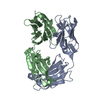
| ||||||||
|---|---|---|---|---|---|---|---|---|---|
| 1 |
| ||||||||
| Unit cell |
|
- Components
Components
| #1: Antibody | Mass: 23374.963 Da / Num. of mol.: 1 / Fragment: Fab fragment Source method: isolated from a genetically manipulated source Source: (gene. exp.) Mus musculus, Homo sapiens / Genus: Mus, Homo / Species: , / Strain: , / Production host:   Escherichia coli (E. coli) Escherichia coli (E. coli) |
|---|---|
| #2: Antibody | Mass: 23113.029 Da / Num. of mol.: 1 / Fragment: Fab fragment Source method: isolated from a genetically manipulated source Source: (gene. exp.) Mus musculus, Homo sapiens / Genus: Mus, Homo / Species: , / Strain: , / Production host:   Escherichia coli (E. coli) Escherichia coli (E. coli) |
| #3: Water | ChemComp-HOH /  Water Water |
-Experimental details
-Experiment
| Experiment | Method:  X-RAY DIFFRACTION / Number of used crystals: 1 X-RAY DIFFRACTION / Number of used crystals: 1 |
|---|
- Sample preparation
Sample preparation
| Crystal | Density Matthews: 2.35 Å3/Da / Density % sol: 47.22 % | ||||||||||||||||||||||||||||||||||||||||||||||||
|---|---|---|---|---|---|---|---|---|---|---|---|---|---|---|---|---|---|---|---|---|---|---|---|---|---|---|---|---|---|---|---|---|---|---|---|---|---|---|---|---|---|---|---|---|---|---|---|---|---|
Crystal grow | Temperature: 298 K / Method: vapor diffusion, hanging drop / pH: 7 Details: PEG 2000MME, pH 7, VAPOR DIFFUSION, HANGING DROP, temperature 298K | ||||||||||||||||||||||||||||||||||||||||||||||||
| Crystal grow | *PLUS Temperature: 25 ℃ / pH: 6.6 | ||||||||||||||||||||||||||||||||||||||||||||||||
| Components of the solutions | *PLUS
|
-Data collection
| Diffraction | Mean temperature: 100 K |
|---|---|
| Diffraction source | Source:  ROTATING ANODE / Type: RIGAKU FR-D / Wavelength: 1.5418 ROTATING ANODE / Type: RIGAKU FR-D / Wavelength: 1.5418 |
| Detector | Type: RIGAKU RAXIS IV / Detector: IMAGE PLATE |
| Radiation | Protocol: SINGLE WAVELENGTH / Monochromatic (M) / Laue (L): M / Scattering type: x-ray |
| Radiation wavelength | Wavelength : 1.5418 Å / Relative weight: 1 : 1.5418 Å / Relative weight: 1 |
| Reflection | Resolution: 2.2→29.83 Å / Num. all: 22829 / Num. obs: 22829 / Observed criterion σ(F): 0 / Biso Wilson estimate: 26.6 Å2 / Limit h max: 26 / Limit h min: 0 / Limit k max: 43 / Limit k min: 0 / Limit l max: 70 / Limit l min: 0 / Observed criterion F max: 743027.98 / Observed criterion F min: 1.58 |
| Reflection | *PLUS Highest resolution: 2.2 Å / Lowest resolution: 20 Å / Num. obs: 22861 / % possible obs: 98.3 % / Num. measured all: 200436 / Rmerge(I) obs: 0.064 |
| Reflection shell | *PLUS % possible obs: 97.2 % / Rmerge(I) obs: 0.209 / Mean I/σ(I) obs: 10.4 |
- Processing
Processing
| Software |
| ||||||||||||||||||||||||||||||||||||||||||||||||||||||||||||||||||||||||||||||||||||||||||
|---|---|---|---|---|---|---|---|---|---|---|---|---|---|---|---|---|---|---|---|---|---|---|---|---|---|---|---|---|---|---|---|---|---|---|---|---|---|---|---|---|---|---|---|---|---|---|---|---|---|---|---|---|---|---|---|---|---|---|---|---|---|---|---|---|---|---|---|---|---|---|---|---|---|---|---|---|---|---|---|---|---|---|---|---|---|---|---|---|---|---|---|
| Refinement | Method to determine structure : :  MOLECULAR REPLACEMENT / Resolution: 2.2→19.82 Å / Rfactor Rfree error: 0.008 / Occupancy max: 1 / Occupancy min: 1 / Cross valid method: THROUGHOUT MOLECULAR REPLACEMENT / Resolution: 2.2→19.82 Å / Rfactor Rfree error: 0.008 / Occupancy max: 1 / Occupancy min: 1 / Cross valid method: THROUGHOUT
| ||||||||||||||||||||||||||||||||||||||||||||||||||||||||||||||||||||||||||||||||||||||||||
| Solvent computation | Solvent model: CNS bulk solvent model used / Bsol: 45.0965 Å2 / ksol: 0.363159 e/Å3 | ||||||||||||||||||||||||||||||||||||||||||||||||||||||||||||||||||||||||||||||||||||||||||
| Displacement parameters | Biso max: 98.71 Å2 / Biso mean: 34.94 Å2 / Biso min: 7.08 Å2
| ||||||||||||||||||||||||||||||||||||||||||||||||||||||||||||||||||||||||||||||||||||||||||
| Refine analyze |
| ||||||||||||||||||||||||||||||||||||||||||||||||||||||||||||||||||||||||||||||||||||||||||
| Refinement step | Cycle: LAST / Resolution: 2.2→19.82 Å
| ||||||||||||||||||||||||||||||||||||||||||||||||||||||||||||||||||||||||||||||||||||||||||
| Refine LS restraints |
| ||||||||||||||||||||||||||||||||||||||||||||||||||||||||||||||||||||||||||||||||||||||||||
| LS refinement shell | Refine-ID: X-RAY DIFFRACTION / Total num. of bins used: 8
| ||||||||||||||||||||||||||||||||||||||||||||||||||||||||||||||||||||||||||||||||||||||||||
| Xplor file |
| ||||||||||||||||||||||||||||||||||||||||||||||||||||||||||||||||||||||||||||||||||||||||||
| Software | *PLUS Name: CNS / Version: 1 / Classification: refinement | ||||||||||||||||||||||||||||||||||||||||||||||||||||||||||||||||||||||||||||||||||||||||||
| Refinement | *PLUS Highest resolution: 2.2 Å / Lowest resolution: 20 Å / % reflection Rfree: 10 % / Rfactor Rwork : 0.236 : 0.236 | ||||||||||||||||||||||||||||||||||||||||||||||||||||||||||||||||||||||||||||||||||||||||||
| Solvent computation | *PLUS | ||||||||||||||||||||||||||||||||||||||||||||||||||||||||||||||||||||||||||||||||||||||||||
| Displacement parameters | *PLUS | ||||||||||||||||||||||||||||||||||||||||||||||||||||||||||||||||||||||||||||||||||||||||||
| Refine LS restraints | *PLUS
|
 Movie
Movie Controller
Controller



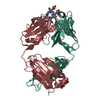

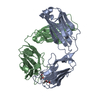
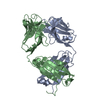


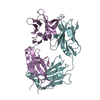


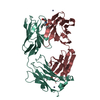






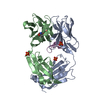


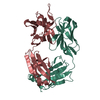
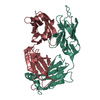


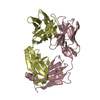

 PDBj
PDBj


